Related Research Articles
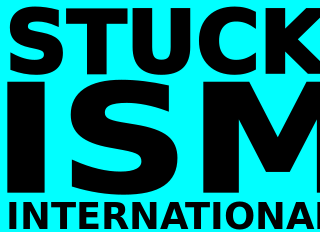
Stuckism is an international art movement founded in 1999 by Billy Childish and Charles Thomson to promote figurative painting as opposed to conceptual art. By May 2017 the initial group of 13 British artists had expanded to 236 groups in 52 countries.

The Young British Artists, or YBAs—also referred to as Brit artists and Britart—is a loose group of visual artists who first began to exhibit together in London in 1988. Many of the first generation of YBA artists graduated from the BA Fine Art course at Goldsmiths, in the late 1980s, while the second generation mostly came from the Royal College of Art.

Damien Steven Hirst is an English artist, entrepreneur, and art collector. He is one of the Young British Artists (YBAs) who dominated the art scene in the UK during the 1990s. He is reportedly the United Kingdom's richest living artist, with his wealth estimated at $384 million in the 2020 Sunday Times Rich List. During the 1990s his career was closely linked with the collector Charles Saatchi, but increasing frictions came to a head in 2003 and the relationship ended.
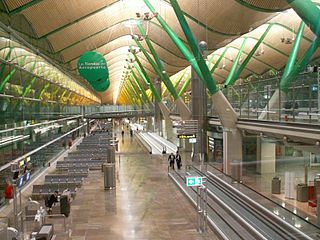
The Royal Institute of British Architects Stirling Prize is a British prize for excellence in architecture. It is named after the architect James Stirling, organised and awarded annually by the Royal Institute of British Architects (RIBA). The RIBA Stirling Prize is presented to "the architects of the building that has made the greatest contribution to the evolution of architecture in the past year." The architects must be RIBA members. Until 2014 the building could be anywhere in the European Union, but since 2015 has had to be in the UK. In the past the award has come with a £20,000 prize, but currently it carries no prize money.

Marcus Harvey is an English artist and painter, one of the Young British Artists (YBAs).
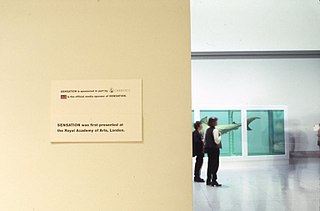
Sensation was an exhibition of the collection of contemporary art owned by Charles Saatchi, including many works by Young British Artists, (YBAs), which first took place 18 September – 28 December 1997 at the Royal Academy of Arts in London. The exhibition later toured to the Hamburger Bahnhof in Berlin and the Brooklyn Museum in New York City. A proposed showing at the National Gallery of Australia was cancelled when the gallery's director decided the exhibition was "too close to the market."
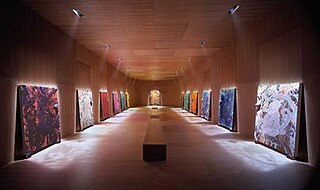
The Upper Room is an installation of 13 paintings of rhesus macaque monkeys by English artist Chris Ofili in a specially-designed room. It was bought by the Tate gallery in 2005 from the Victoria Miro Gallery and was the cause of a media furore after a campaign initiated by the Stuckist art group as Ofili was on the board of Tate trustees at the time of the purchase. In 2006 the Charity Commission censured the Tate for the purchase, but did not revoke it.
Art intervention is an interaction with a previously existing artwork, audience, venue/space or situation. It has the auspice of conceptual art and is commonly a form of performance art. It is associated with the Viennese Actionists, the Dada movement and Neo-Dadaists. Stuckists have made extensive use of it to affect perceptions of artworks they oppose and as a protest against existing interventions.

Stuckist demonstrations since 2000 have been a key part of the Stuckist art group's activities and have succeeded in giving them a high-profile both in Britain and abroad. Their primary agenda is the promotion of painting and opposition to conceptual art.

Art historians and philosophers of art have long had classificatory disputes about art regarding whether a particular cultural form or piece of work should be classified as art. Disputes about what does and does not count as art continue to occur today.

The Stuckism International Gallery was the gallery of the Stuckist art movement. It was open from 2002 to 2005 in Shoreditch, and was run by Charles Thomson, the co-founder of Stuckism. It was launched by a procession carrying a coffin marked "The death of conceptual art" to the neighbouring White Cube gallery.

The Physical Impossibility of Death in the Mind of Someone Living is an artwork created in 1991 by Damien Hirst, an English artist and a leading member of the "Young British Artists". It consists of a preserved tiger shark submerged in formaldehyde in a glass-panel display case. It was originally commissioned in 1991 by Charles Saatchi, who sold it in 2004 to Steven A. Cohen for an undisclosed amount, widely reported to have been at least $8 million. However, the title of Don Thompson's book, The $12 Million Stuffed Shark: The Curious Economics of Contemporary Art, suggests a higher figure.
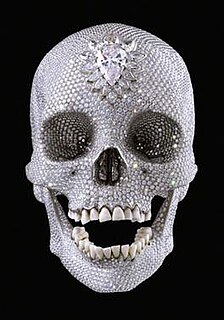
For the Love of God is a sculpture by artist Damien Hirst produced in 2007. It consists of a platinum cast of an 18th-century human skull encrusted with 8,601 flawless diamonds, including a pear-shaped pink diamond located in the forehead that is known as the Skull Star Diamond. The skull's teeth are original, and were purchased by Hirst in London. The artwork is a memento mori, or reminder of the mortality of the viewer.
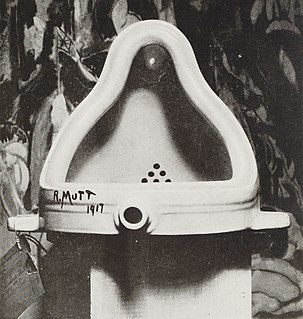
Shock art is contemporary art that incorporates disturbing imagery, sound or scents to create a shocking experience. It is a way to disturb "smug, complacent and hypocritical" people. While the art form's proponents argue that it is "imbedded with social commentary" and critics dismiss it as "cultural pollution", it is an increasingly marketable art, described by one art critic in 2001 as "the safest kind of art that an artist can go into the business of making today". But while shock art may attract curators and make headlines, Reason magazine's 2007 review of The Art Newspaper suggested that traditional art shows continue to have more popular appeal.

John LeKay is an English conceptual and installation artist and sculptor, who lives in New York City. In 1993, he began to make skulls covered in crystal: he has accused Damien Hirst of copying this and other ideas. He publishes the web site, heyokamagazine.
Carolina Biological Supply Company is a supplier of science and math education materials to teachers, college professors, home-school educators, and professionals in health and science-related fields in the United States.

Beautiful Inside My Head Forever was a two-day auction of new work at Sotheby's, London, taking place on 15 and 16 September 2008. It was unusual as Damien Hirst bypassed galleries and sold directly to the public. The sale raised £111 million for 218 items. The auction exceeded expectations, setting a record for a single-artist auction, occurring as the financial markets plunged.
Cartrain, often stylised cartяain, is a British artist associated with the graffiti urban art movement.

Portrait of Jacob de Gheyn III is a 1632 oil on canvas portrait by Rembrandt of the engraver Jacob de Gheyn III, now in Dulwich Picture Gallery. It is smaller than most of Rembrandt's works, measuring only 29.9 by 24.9 centimetres. It has been stolen numerous times and its size is one factor that has contributed to its numerous thefts.
Barry Joule is a Canadian writer, and a long-time friend of the artist Francis Bacon who died in 1992 and left a substantial amount of his archive material to Joule. He was also a friend of the dancer Rudolf Nureyev and model Toto Koopman.
References
- ↑ Mathographics at Google Books
- 1 2 Widdup, Ellen (24 October 2006). "Can you spot the difference". London Evening Standard.
- ↑ Alberge, Dalya. (14 August 2003). "Spot the difference as artist accuses Hirst of copying", The Times . Retrieved 8 February 2008.
- ↑ Alberge, Dalya. (27 June 2007). "My old friend Damien stole my skull idea", The Times . Retrieved 10 December 2007.